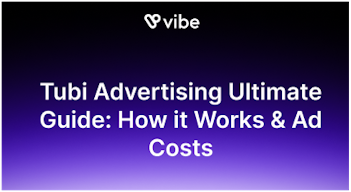CTV Advertising Innovations in 2024
2024 started off strong, burying advertisers under a veritable avalanche of Streaming TV Advertising feature and performance innovations finally reaching maturity.
For years, tech writers have breathlessly expounded on the “promise” of CTV advertising, citing an ever growing viewership and increasingly reliable tech, but 2024 is the year CTV advertising finally goes mainstream, delivering trackable, optimizable results across industries and budget sizes.
Learn more about the integrations, feature updates, evolving best practices, and macro trends we are most excited about this year, both at Vibe and in the Streaming TV advertising industry at large.
CTV ad budgets will grow faster than ever
Why? For the same reasons they have been for years, and a few new ones:
Powerful, Cookie-less Targeting
Although Google’s 3rd party cookie deprecation deadline has been looming over digital advertisers for years, we all woke up with a slightly more urgent sense of dread this January, as 1% of all Chrome users saw their 3rd party cookie tracking shut off, with many more to come before Google meets their July 2024 cookie deprecation deadline. What does all of this mean? Well, for years now, 3rd party cookies have allowed digital advertisers - like social media platforms, for example - to follow various audiences’ browsing history across channels and websites in order to serve them personalized ads, but those days are coming to an end.
A recent Adobe survey found that “83 percent of leaders at cookie-dependent companies say that at least 30 percent of their total potential market is in environments where third-party cookies don’t work, such as social media platforms and on Apple devices.” Today, digital advertisers will need to diversify their audience targeting tactics to keep serving the right content to the right viewers. Thankfully, groundbreaking, privacy-compliant targeting technology is coming out fast and furious this year, with CTV IP targeting leading the charge.
Privacy-safe targeting and massive growth in high-quality streaming inventory are probably the top two reasons Streaming TV Advertising will see its fastest growth yet in 2024. Thanks to IP Household targeting, household audience graphs, and 1st party pixel tracking, CTV ad platforms like Vibe.co are able to target hundreds of custom audiences and reliably measure anything from ROAS to CPIs to Cost per Sessions, and more.
Meanwhile, streaming TV audience signals are increasingly coming from mobile devices, allowing beleaguered mobile advertisers to regain some of the targeting traction they lost when Apple’s ATT update launched, followed by increasingly stringent regulations across states like California and Colorado. They can now seamlessly deliver streaming ads across devices (tablet, mobile, TV) and device types (Android, Apple) for comprehensive, granularly targeted campaigns outside of Apple or Google’s frameworks.
A Favorable Economic Environment
Although economists have been hemming and hawing rather than give a straightforward economic forecast for over a year now, studies across geographies and industries all predict:
- Significant ad spend increase on Streaming TV platforms
- A quickly receding threat of a recession
- Streaming advertising’s exponential growth across Europe
Across the board, 2024 will see massive investment in Streaming TV advertising for the above mentioned reasons, and more. A study conducted at the very end of 2023 found that 2-in-3 advertisers using CTV plan to increase their spending in 2024, while BIA projects CTV/OTT to be the fastest-growing media channel, with an increase of 39.5% in ad spend from 2023.
Meanwhile, audiences across the pond are finally getting comfortable with a new medium. According to VideoWeek’s 2024 CTV Report, “BVOD platforms now reach millions of people in Europe: for example, MYTF1 in France has reached peaks of 30 million unique users per month, while Channel 4 in the UK counts 29 million registered users [...] This mode of media consumption creates an ideal environment for brands to capitalize on reaching an audience that is both large and segmented, whilst highly engaged.”
This means large advertisers can finally expand their streaming advertising strategies across markets while smaller European businesses can finally dip their toes in a rapidly growing pool. This shift will only accelerate innovation and contribute to keeping the medium ever-more robust.
Event-Focused Streaming
Meanwhile, 2024 will be a banner year for televised programming (and advertising) thanks to 2024 Presidential Elections in the US and the Summer Olympics held in Paris this July. More eyeballs, more inventory, more opportunities for impactful advertising!
Political ad spending was already one of the fastest growing verticals in the CTV ecosystem last year, but increased targeting capabilities including voter registration status, ZIPcode inclusion or exclusion, household income, political affiliation and more will send budgets into overdrive.
As for sports streaming, the most exciting evolution of CTV in 2023 was, arguably, the untangling of the Live Sports Gordian knot which had us twisting ourselves into pretzels to figure out where live games could actually be streamed. As of late last year, Fubo, Sling, Amazon Prime, and YouTube TV all made big moves to gain exclusive game rights, and the Olympics will be no different.
NBCUniversal’s streaming platform Peacock is set to stream every sport and event live throughout the Games, with dozens of other streamers offering event-specific programming (the golf channel, Univision, ESPN+, etc.) That’s a massive, highly-engaged audience that advertisers will want to segment and target programmatically on CTV.
Of course initial spend won’t last without reliable measurement and optimization capabilities. Lucky for us, that’s our next big prediction (really more of a promise) for 2024: more reliable, more robust CTV ad campaign measurement.
Complex and Complete Measurement
The death of short-sighted last touch attribution is often pointed to as a sign digital advertising is maturing, but thousands of brands, especially SMBs and smaller digital agencies, still live and die by the conversions Meta and Google (conveniently) attribute to themselves. Managing campaign budgets by prioritizing channels that lead to conversion makes sense on the surface, but it fails to account for powerful recent innovations in the CTV, audio, and DOOH spaces that:
- Add meaningful client touchpoints to an increasingly fragmented buyer’s journey
- Measurably lift campaign performance across channels
- Capture audience attention in a brand new way
- Target custom audiences in a privacy-compliant, cookie-less environment
The point here isn’t to say that legacy digital channels should be abandoned in favor of newer platforms, but rather that diversification both in campaign strategy and in measurement is crucial to managing impactful ad campaigns in 2024. In the words of SVP of analytics and data science at Media Matters Worldwide Sarah Owens, “Whether you’re running a brand campaign and you’re measuring attitudinal metrics like lift in awareness or purchase consideration, or if it’s more of an acquisition campaign and you’re tracking sales and conversion rate, those are outcomes. And that’s what every marketer should be using, and that’s available today.”
Today, robust CTV ad platforms offer many ways to measure and manage impact, from 1st party web traffic, purchase, and click tracking to MMP integrations, to co-viewing measurement, to MMM modeling and more. This year, as marketers and agencies seek a deeper understanding of effective measurement strategies for CTV using eCPMs and programmatic technology, they will become increasingly comfortable understanding what percentage of their TV ad budget is delivering ROI which is why, according to Ad Exchanger, “this level of granularity that is starting to attract not only traditional TV advertisers to CTV but those historically absent from TV ad buys.”
Vibe.co is starting off the year with Google Analytics integration for simpler omni-channel reporting, easier pixel installation to track CTV-enabled web visits, clicks, and purchases, more MMP integrations, Mixed Model Marketing vendor partnerships, advanced retargeting capabilities and more so brands of all sizes can feel confident in their results.
Performance-Focused Innovations Ahead
AI Optimizations
AI is on everyone’s minds this year, but before you start imagining evil robot overlords, know that Vibe has been leveraging machine learning for years to optimize real-time bidding, render video previews, approve client video content rapidly with ACR (Automatic Content Recognition) and more. This year will be no different. The industry at large will continue to lean hard on AI to improve everything from platform onboarding to video asset customization.
In years past, CTV advertising adopters were, by and large, marketers who had already advertised on “traditional” TV and wanted to diversify, but as TV newcomers continue to open up to the promise of CTV, AI will be a fundamental part of facilitating the transition process by, for example, allowing digital advertisers to rapidly repurpose and customize assets they have ready for social media platforms or to manage programmatic bidding so prices stay extremely competitive. AI will also allow for more advanced optimizations like ad frequency capping, context targeting, and interactive ad creative.
Finally, interactive CTV ads - though still rare - are already a majorly significant innovation for performance-focused CTV ads. Roku tried out the format with Walmart in late 2023 and Hulu already offers clickable pause ads which further incentivize an already hyper-engaged audience to take action: in the past year, 70% of TV streamers have taken direct action after seeing an ad on TV and are 30 percent more likely than non-TV streamers to take action; behavior that advertisers will be increasingly taking advantage of this year.
FAST Channels
Free Ad Supported TV channels exploded this year as consumers grew weary of paying for dozens of expensive subscription services, especially once original show content started dwindling due to the writers’ strike. After a honeymoon phase during which SVODs like Netflix got flooded with awards and dollars, TV viewing habits are beginning to return to something more akin to the cable experience - only with more choice and for less money.
FAST channels are built for ads, usually by companies with a long history of working with television advertisers (ViacomCBS owns Pluto, Fox owns Tubi, NBC owns XUMO, etc.). This means their infrastructure is meant to work for advertisers: seamless ad integration into the content stream, low CPMs, transparent reporting, etc. Major broadcasters are leaning on FAST channels to recuperate some of their losses to streaming and now that channels like Fubo are streaming sports programming, the category will grow exponentially this year.
Live Sports
Because big tech players often have more cash on hand (Apple has $64.2 billion and Google has $118.3 billion as of June 2023), they’re able to outbid legacy media companies (like Comcast at $$7.1 billion) without taking on liabilities, which further comforts analysts in their predictions the move to sports streaming is here to stay.
Meanwhile, lesser known but fast growing leagues in European soccer and college sports are diversifying their monetization strategies - and courting brand new advertisers in the process - by striking rights agreements with Peacock, ESPN+, and Paramount+, for example.
While billion dollar sports rights deals may have made more headlines than the steady growth of live programming aggregators like Fubo, the latter’s model is by far the most innovative and user-friendly for both viewers and advertisers, who can now easily access the games (and premium environments) through one platform and/or subscription, thus improving the user experience and minimizing the need for marketers to spread budgets across several platforms to reach sports fans and advertisers looking for solid ROAS this quarter should take notice.
In order to truly enhance live sports viewing and advertising experiences, streaming providers still need to optimize lag time and maintain reliability, but the technology behind complex CTV environments has improved exponentially in the last few years, which explains why media giants are finally making a real move to radically shift the live television model. Today, services like Sling, Amazon Prime, or Peacock are delivering live broadcasts with the same reliability and speed linear TV viewers have come to expect, and the list keeps growing.
Advanced Targeting
As mentioned earlier, 3rd party cookie deprecation this year is heightening the stridency with which advertisers are demanding targeting power from their digital vendors, but really it’s nothing new. Granular targeting is the reason behind Streaming TV advertising’s meteoric rise, and performance-focused platforms will continue to push for more accurate, impactful, and trackable audience targeting this year.
Solid CTV ad platforms already have dozens of custom targeting segments to offer, but this year they will (or should) be focused on advanced targeting tools like refined retargeting offerings, CRM list targeting or exclusion, and mapping household graphs to enhance accuracy and impact.
Of course all of the above developments will mean nothing without education, which leads us to our last major prediction for the year: ad tech leaders will majorly shift which media buying personas they appeal to and massively invest in SMB education and adoption. This is the year SMB marketers dare to enter the CTV ad space.
CTV Best Practices in 2024
In light of shifting industry benchmarks, tactics, and tools, streaming TV advertisers would do well to broaden their Best Practices checklist beyond defining clear goals and compelling CTAs. Here are some of our favorites:
Don’t be afraid to diversify
Make sure your team has the authority and flexibility to leverage all signals available to them and diversify their advertising strategy and channel mix. As consumer attention continues to fragment, remain focused on your target audience (as opposed to a specific channel type) and overall campaign performance vs. unreliable last touch attribution results.
Embrace programmatic advertising
Although some may still associate programmatic CTV advertising with poor quality inventory and unsupervised bidding frenzies, robust CTV ad platforms like Vibe have created competitive, brand-safe environments that continue to push performance further, thanks to granular, data-driven targeting, AI optimized real-time bidding to keep prices low and reach high, and consistent cross-platform coordination.
Act on real-time insights
With the right vendor, programmatic CTV ad campaigns can be monitored and optimized in real-time both in single or multivariate formats, but all of those insights won’t matter if you are not prepared to act on them. Vibe’s detailed reporting module allows advertisers to understand which channels, targeting dimensions, and creative assets garner the most impressions, clicks, and/or purchases in order to further refine their campaigns and audience segmentation efforts.
Keep your creative coherent across formats and platforms
As customer acquisition channels continue to diversify, consumers will need to pay special attention to maintaining coherence across campaign channels and offer customers a friction-less brand experience, both from a messaging and a creative perspective.
For more on Streaming TV advertising, visit our Insights Center.


